Shikoku Part II: Cold Snap -- 四国その二「厳しい冷え込み」

Morning of Day 3: Hiroshima Prefecture. The skyline of Onomichi on the Honshu side of the Shimanami Highway -- typical of a small Japanese city.
三日目の朝広島県の尾道市のスカイラインが見えます。
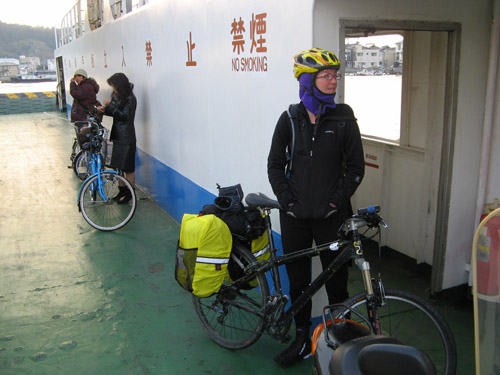
The bridge over the final, narrow strait to Honshu cannot be traversed by bicycle, so we took a short ride on a small ferry along with some local, more practical cyclists. Close up, Onomichi turns out to be a pleasant town: lively fish markets bustle with local people shopping for their day's sustenance. We find virtually authentic French patisserie where we can't but stuff ourselves with delicious croissant sandwiches that power our journey for the rest of the morning.
本州までの最後の橋は自転車で通れないのでフェリーに地元のサイクリストと一緒に渡ります。魚の市場がにぎやかで美味しいパン屋さんもあるので尾道市は良い印象が残っています。

Seemingly endless stretches of trashy suburbs and industrial parks await us down the length of the Honshu coast as we leave Hiroshima Prefecture for Okayama. Cities with names such as Fukuyama and Kurashiki, though somewhat larger than Onomichi, seem drab and lifeless. We push on, straining to find some beauty somewhere. Perhaps in the starkness of the cold silvery light streaming down from the cold winter sky.
本州の広島県から岡山県の海沿いで漕ぐと工業地域や市街地が次々と並んでいる。一日中景色が余り変わらないでキツイです。美しい冬の澄んだ夜空で慰めを見つけた。

By mid afternoon, showers come down, and bad weather threatens; we take shelter in a large concrete gazebo on a roadside beach. As we pace about trying to stay warm and pass time, the radio weather forecast announces a cold snap due the next day. Now, at least in West Japan you have to take this with a grain of salt - by the way the locals react to the slightest chill, one might assume their ancestors come straight from Tahiti. Nevertheless, we are somewhat apprehensive. Indeed, the next day dawns with low, racing clouds and freezing temps.
昼下がりになると雨が降り始めて、天気が悪くなるので海水浴場の東屋で夜までウロウロします。天気予報によると翌日から厳しい冷え込みに入る。今回天気予報は当たります。次の日は凍えるほど寒い天気になってしまいました。
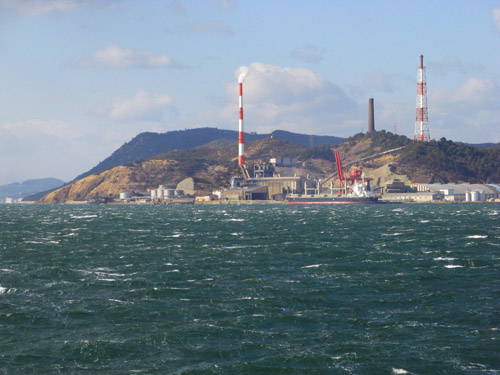
A northwest gale blows most of the day and the next; thankfully it is at our backs as we make our way ever eastward. The breeze does its best to rough up the landlocked Inland Sea, affording us a chance to snap a couple interesting pictures from the ferry to Takamatsu City. Back to Shikoku again!
北西の嵐の追い風を利用して東の方へ進みます。 四国までフェリーに乗ると荒れた瀬戸内海を眺める。
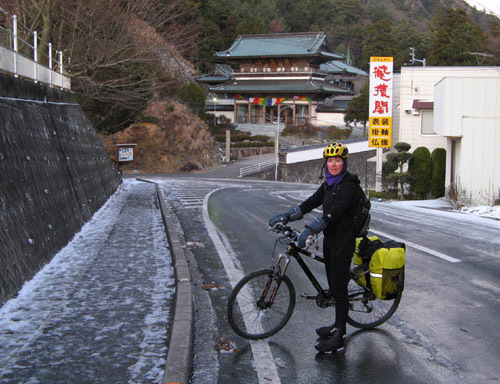
We are glad to be finally escaping the crowded, trashy cities and heading into the hills, but the landscape freezes as soon as we gain any altitude. Black ice completely coats the road at Obonji, the 88th and last along the famous temple pilgrimage trail around Shikoku. Coldest of all is the way back down; some sections are accomplished with one foot firmly braced against the ground, sliding down with the bike in a more or less stable triangular configuration.
やっと工業地域や市街地から離れて、標高が上がるにつれて気温が下がる。四国巡礼の88番の山の中の大窪寺まで登ぼると道が完全に凍結。自転車を乗りながら一本の足を地面まで伸ばして、押さえながらなんとなく山から下る。
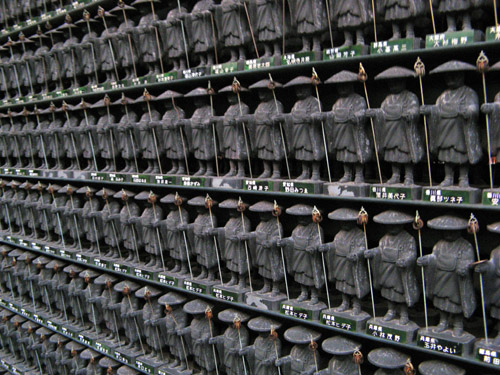
We're not sure, but these figurines at Obonji perhaps commemorate those who successfully finished the full pilgrimage. Real pilgrims in more or less the same getup were a common sight where our tour happened to coincide with the o-henro or pilgrimage route. O'Henrys, we began to call them, telling something of our own mental state as well. Early-retirees, midlife crisis 'salarymen', young men at odds with the cog-in-the-machine arrangement that is Japan, on a wander in search of some meaning in the unfathomable emptiness that stretches just beyond the thin skin of tangible reality.
このミニお遍路さんはどう言う意味かちょっと分からない。四国巡礼のを記念する物かも。この像と似ているお偏路さんが旅の間にたまに会います。アメリカの有名なチョコレートの菓子のオヘンリーがあるのでお遍路さんが見かけたら"Oh Henryだ”と冗談で呼んだ。お腹がぺこぺこのせいでその変な名前を考えただろう。
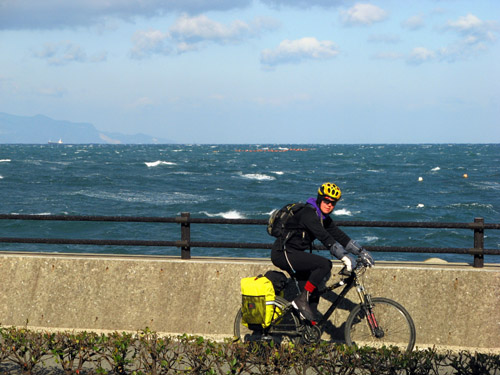
Where the mountain and sea meet they crowd out the cities. As one nears the Naruto at the east end of Shikoku, there is only enough space for a two lane road between the salt waters and the hills. Come to think of it, we could be equally (un)comfortable in our kayaks traveling on the other side of the coastline.
四国の東の方に海と山の間に道のスペースしかない。この海はカヤックで漕ぎたいなぁ。
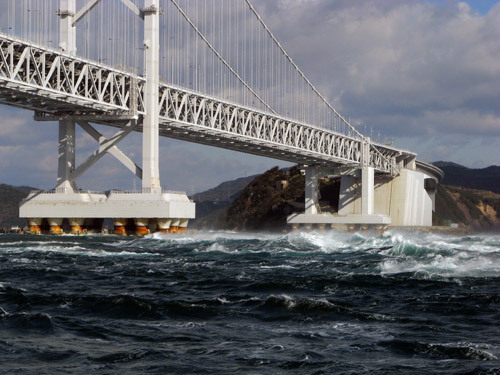
The Naruto Strait is one of the few places we specifically planned to see on this tour. A drastically narrow pass links the Inland Sea to the Pacific Ocean, leading to the most violent tidal currents in all of Japan. With anticipation we board a tour boat and minutes later come face-to-face with roaring rip currents the likes of which we'd never seen. In conjunction with the windy weather, the ship is so awash in spray it is hard to take any pictures! (Still, I think I could take these waves on in a kayak.) Anyway, we were lucky: as our ship comes back, the captain cancels the rest of the afternoon tours, citing rough weather.
この旅の一つの目的は鳴門海峡を見に行くことでした。瀬戸内海と太平洋をつなぐ激狭い鳴門海峡は日本で一番早い潮流があり渦潮は有名です。遊覧船に乗って、強い風と流れによるスリルの経験でした。カヤックでやってみたいなぁ。
この時リックは親父ギャグを出した
船から下りて、里杏はもう一回行きたいなぁと言って、リックは次の船はもう欠航になっている知らせを見て、。。いいえケッコウですと答えました。hahaha.

Another view of the strait, with freighter for scale.
海峡を通り抜けている貨物船を見ると海峡はどの位狭いのが分かるでしょう。
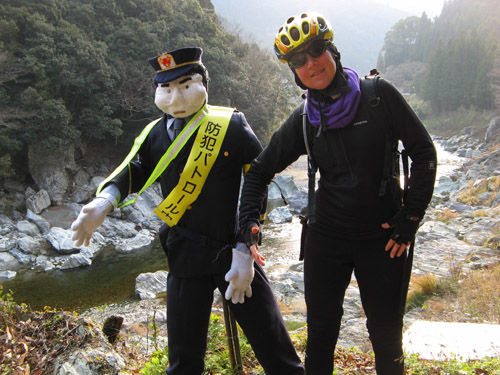
After Naruto, it is time for the Tsurugi Mountains, an extensive and remote area that fills much of the inland of eastern Shikoku. As soon as we leave the lowland cities behind, we are exposed to the poignant culture of the inaka (boondocks). Notable are lifesize figures recalling common sights of country life, such as this traffic officer. Thousands such volunteers help elementary school students get to school safely every day in Japan. Community service minded Leanne takes some pointers. If you like these dolls, check out Leanne`s blog for more.
次は東四国で広大の剣山地へ向かう。この手作り伝統的な人形がすばらしい。誰が作ったでしょう。この人形が好きなら里杏のブログをご覧ください。
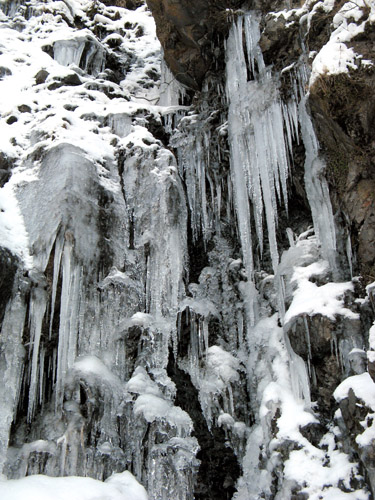
Climbing toward 1060m Dosu Pass, we finally gain height in a serious way and enter the snowy, frozen scapes of the inner Tsurugi Mountains.
1060mの土須峠まで登って、雪が深くなってしまいました。
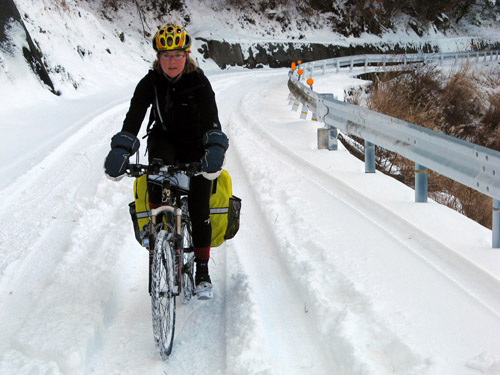
Although many are national highways, the twisty roads that barely manage to cut through this difficult topography present no shortcuts from anywhere to anywhere. Suddenly we are down to meeting only two or three cars per day, surrounded instead by a heavenly, natural quiet. It's a stark contrast to the unsightly, noisy cities on the plains. And still, equally desolate. So why do we feel so much more comfortable here? The cold and the snow are still much preferrable to diesel fumes and constant sight of run-down plastic siding.
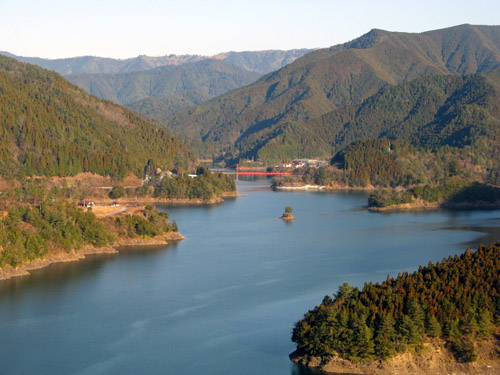
Drifting south, we stay high and leave the snows behind. Clearly the northern ridges we left behind caught most of the storm's precipitation. Now approaching the Pacific Ocean with its warm currents, the vegetation too seems to change to include more evergreens like the ones we are used to in our home islands of Amakusa. But this is a more remote place, with only logging roads, the odd dam, and nary a vending machine or shop in sight.
南へ進むと雪が少なくなる。温流がある太平洋に近づくと植物は九州の天草と似るようになります。しかしこの辺では自動販売機や店もなく伐採道路やダムしかない。

Labels: shikoku bike tour 四国自転車ツアー


3 Comments:
海のそばから、雪の積もる高い山まで、ほんとよく走ったよね~!
二人の人並みはずれた?体力にただただ感動です。
By kazumi, at 9:29 am
kazumi, at 9:29 am
Was late,; but A Happy New Year.
it`s very powerful to the mountains of Shikoku for a winter vacation
The doll is unique and is happy, and the father gag of "ケッコウ" is healed, too(笑)
I look forward to your powerful diaries again.
By takaaki nisikawa, at 3:00 pm
takaaki nisikawa, at 3:00 pm
happy birthday nishikawa. thanks for the nice comment on our blog. kazumiちゃん, why don`t you rent some bicycles when you go to Okinawa. 体力を挑戦してね。
By Leanne and Rik Brezina, at 12:38 pm
Leanne and Rik Brezina, at 12:38 pm
Post a Comment
<< Home